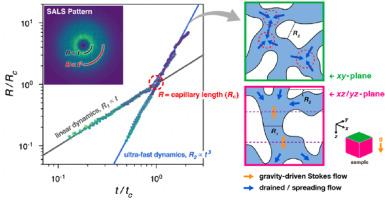临界二元聚合物混合物后期旋光分解中的超快粗化动力学
IF 4.5
2区 化学
Q2 POLYMER SCIENCE
引用次数: 0
摘要
本工作旨在利用自制的时间分辨小角光散射(SALS)装置阐明临界聚合物混合物中后期spinodal分解的超快动力学。当畴尺寸超过毛细管长度时,观察到从界面张力驱动的线性动力学到超快速动力学的交叉。根据我们的后期旋量分解流体动力学模型,考虑了重力驱动的加速斯托克斯流引起的超快动力学。同时,由界面张力驱动的粗化引起的加速度,增大了下降相的尺寸,增加了Stokes流的终端速度。尽管渗流相分离结构在xy平面(平行于重力的法向量)上自相似地生长,但我们认为流体管将沿着z轴伸长,导致三维空间中的动态标度假设失效。最后,SALS数据还显示,只要相分离相之间存在密度差,引力效应就会出现。除了从一种动力学过渡到另一种动力学外,界面张力驱动的泊塞维尔流和重力驱动的斯托克斯流之间的竞争决定了后期旋量分解过程中粗化动力学的主要模式。本文章由计算机程序翻译,如有差异,请以英文原文为准。


Ultra-fast coarsening dynamics in late-stage spinodal decomposition of critical binary polymer mixtures
This work aimed to elucidate the ultra-fast dynamics of late-stage spinodal decomposition in critical polymer mixtures using a home-built time-resolved small-angle light scattering (SALS) apparatus. A crossover from the interfacial-tension-driven linear dynamics to the ultra-fast dynamics was observed when the domain size exceeded the capillary length. According to our hydrodynamic model for late-stage spinodal decomposition, the ultra-fast dynamics is considered induced by the accelerating gravity-driven Stokes flow. At the same time, the acceleration is caused by the interfacial-tension-driven coarsening, which enlarges the size of the falling phase and increases the terminal velocity of the Stokes flow. Although the percolating phase-separating structure grows self-similarly on the xy-plane (normal vector parallel to gravity), we consider that the fluid tubes will elongate along the z-axis, resulting in the failure of the dynamical scaling hypothesis in the 3D space. Finally, SALS data also revealed that the gravitational effects should appear as long as there is a density difference between the phase-separating phases. Apart from a transition from one dynamics to another, it is the competition between the interfacial-tension-driven Poiseuille flow and the gravity-driven Stokes flow that determines the predominant mode of the coarsening dynamics in the late-stage spinodal decomposition process.
求助全文
通过发布文献求助,成功后即可免费获取论文全文。
去求助
来源期刊

Polymer
化学-高分子科学
CiteScore
7.90
自引率
8.70%
发文量
959
审稿时长
32 days
期刊介绍:
Polymer is an interdisciplinary journal dedicated to publishing innovative and significant advances in Polymer Physics, Chemistry and Technology. We welcome submissions on polymer hybrids, nanocomposites, characterisation and self-assembly. Polymer also publishes work on the technological application of polymers in energy and optoelectronics.
The main scope is covered but not limited to the following core areas:
Polymer Materials
Nanocomposites and hybrid nanomaterials
Polymer blends, films, fibres, networks and porous materials
Physical Characterization
Characterisation, modelling and simulation* of molecular and materials properties in bulk, solution, and thin films
Polymer Engineering
Advanced multiscale processing methods
Polymer Synthesis, Modification and Self-assembly
Including designer polymer architectures, mechanisms and kinetics, and supramolecular polymerization
Technological Applications
Polymers for energy generation and storage
Polymer membranes for separation technology
Polymers for opto- and microelectronics.
 求助内容:
求助内容: 应助结果提醒方式:
应助结果提醒方式:


